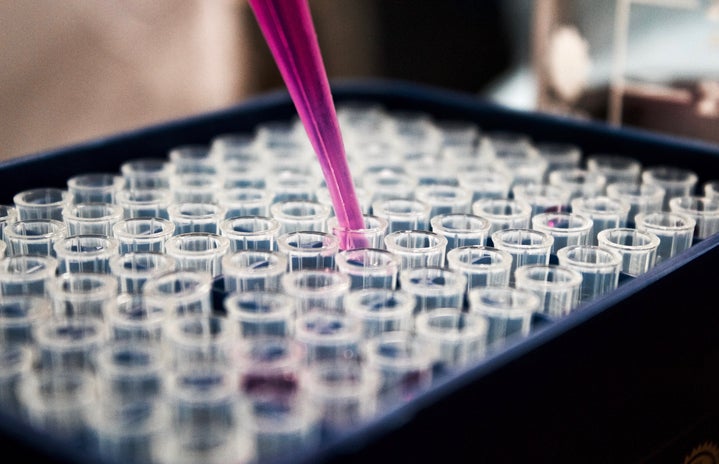Genetically-modified organisms (GMOs) have become more and more prevalent in our food, our clothing, and even our movies. While most everyone is aware of this development – featured in such movies as Gattaca (1997) and the wildly different Rampage (2018) – nuanced discussion of it tends to be overshadowed by inflammatory headlines like “Spider DNA is in Your Lettuce!” Considering this, it might be a good idea to take a step back, remove all the terms like “Cas9” and “reverse transcriptase” from the equation, and talk about GMOs. In addition to the courses I have taken on the subject, I also spoke to Dr. Endang Septiningsih at Texas A&M about this. Dr. Septi, as she encourages her students to call her, teaches the course Biotech Crop Improvement, which features a debate on the pros and cons of GMOs near the end of the semester.
Talking about genes
First, I must make clear that there is some level of translation required for this. Science and English are not the same language. Scientists say things like, “There is no evidence that proves this is linked,” whereas the public wants to hear, “We are absolutely certain that this is not linked.” And Science, as a language, does not operate that way. Half the battle of discussing GMOs is simply the translation, both turning scientific terms (like the aforementioned “Cas9”) into layman’s terms, and also solving this dialectal difference. This creates a fundamental disconnect in the way researchers, government officials, and consumers talk about the same thing.
Second, the ideas behind GMOs are not, in any way, a new thing. Humanity has been changing our produce since we first learned to grow it. We took seeds from the trees with the most fruit, oranges with the sweetest juice, flowers with the biggest blooms. Over hundreds of generations, we created corn from the unrecognizable teosinte, which was so small and hard to eat that it required being ground up and turned into a flour, resulting in corn tortillas being a staple of Latin American cuisine to this day. GMOs, along with cross-breeding and mutagenesis, are simply a new way to introduce these changes, and in a much quicker time frame.
Approval and abundance
This does not make them inherently sinful, nor inherently saintly. They undergo rigorous testing to ensure they are safe for consumption. Bt brinjal, a variety of eggplant that resists insect pests and is very popular in India, was developed in 2000 and only approved to be sold commercially in 2009. Golden rice, produced in the Philippines, took 17 years to be approved for commercial sale, likely due to it being aimed at helping pregnant women and children with malnutrition. To that end, there are only 10 crops that are genetically modified and available in American stores, though those crops may have many approved varieties. Wheat, for example, is not yet genetically modified, so all wheat bread is automatically GMO-free. Corn, on the other hand, has 33 approved GM varieties. There is precisely one genetically modified apple: the Arctic Apple, which is modified to prevent browning when cut.
Dr. Septi, prior to working at A&M, worked with the International Rice Research Institute, based in the Philippines, and produced a variety of rice resistant to flooding. Swarna – the rice variety grown in much of South Asia – was consistently losing produce to the flash floods prevalent in Bangladesh, so Dr. Septi’s team produced Swarna-Sub1. Technically speaking, though its production did involve genetic engineering, Swarna-Sub1 is not a GMO. Sub1 was produced with the use of Quantitative Trait Loci, or QTLs, which work as markers to ensure the transfer of a gene from parent to offspring.
This exclusive club of genetic modification means that the “Non-GMO Verified” sticker many products proudly display are sometimes absolutely meaningless. For example: as there are yet to be any GM citrus, every bottle of orange juice on display at HEB is GMO-free, whether or not they bear the advertisement of it. In contrast, many candies cannot claim to be GMO-free, as they get their sugar from GM sugarbeets. And Swarna-Sub1, while genetically engineered, does not qualify as a GMO.
impact abroad
Scientific discoveries, societal thought, and governmental policy are not singular beings. They are entangled, a web of affecting others and being influenced. A phone is invented; the public buys it and has complaints; the government regulates sale, privacy, and internet providers; the developer improves the device; and so on. The same is true with genetic modification technology. To explore that with GMOs, here is an example:
A genetically modified corn variety is introduced to the global market, grown in America. It sells well among ranchers in Mexico, who use it as feed for their cattle. The international public has concerns about gene editing, especially regarding the potential of cross-breeding with native species, so the Mexican government reacts, prohibiting the purchase of GM corn. The ranchers must now find a new way to feed their cattle, and US farmers face losing their second-largest importer of corn, after China.
This is not a hypothetical. This precise situation is still ongoing, with the Biden administration promising to take the first steps to challenge this ban this year. This entanglement means that public fears affect governmental policy, which trickles down through producers like American growers and Mexican ranchers. The reverse is also true, as governmental restrictions can then imply to a concerned consumer that they were right, because why would it be restricted if it weren’t dangerous? In Europe, any product with more than 0.9% genetic modification in its genome is not approved to be sold, and European scientists object to this threshold, as there is no scientific evidence that it is an indication of danger or safety.
There are, absolutely, downsides to GMO farming. One of the biggest is fear of lawsuits, as Monsanto sued organic farmers in 2013 over their patented genome, and won in a landside. PepsiCo, as well, sued 4 farmers in 2019 in India for growing the potato used for Lays chips, the FC5 potato. The lawsuit was retracted after international backlash, but many farmers – especially small, rural, international farmers – are now fearful, and avoid GMO production even with the potential benefits that growing Bt brinjal or Swarna-Sub1 rice could offer them.
Genetic modification is rapidly becoming popular around the world. They offer myriad of nutritional, environmental, and financial benefits. However, the social, political, and legal implications and affects they are having on the world require drastic changes to our systems, better communication, and thoughtful, considerate discussion of every angle of these issues. Without that, the potential benefits will always be outweighed by natural human fear.


